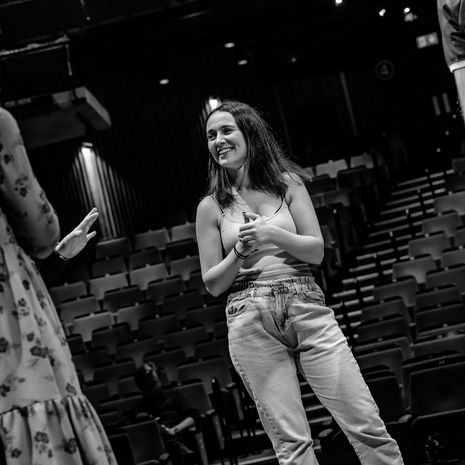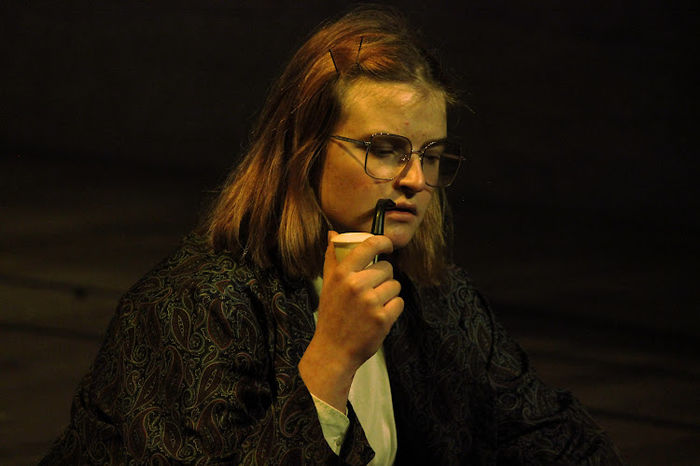Murder in the Dark, study at the ADC
Kasia Gibson talks to Sasha Brooks about the lessons of Cambridge theatre, the role of understudy, and upcoming mystery Murder in the Dark

“I think the beats of horror and comedy are actually really similar,” Sasha Brooks tells me, as we unpack the challenge of performing horror on a stage. Brooks, a Cambridge University alum, is performing in Cambridge for the first time since her student days, making her professional debut in touring mystery Murder in the Dark. The show is marketed as a horror/thriller, but Brooks explains that fitting it into a single category doesn’t do it justice: “it’s not just the horrors. You really want to find out where things went wrong and why this family is the way that it is… There’s also a lot of comedy.” The tone of the show is the product of several moving parts, with lighting, sound and performance all playing crucial roles. But it is through this humour that a false sense of security is created – letting jumpscares really give the audience the heebie-jeebies.
"Brooks, a Cambridge University alum, is performing in Cambridge for the first time since her student days, making her professional debut in touring mystery Murder in the Dark"
It’s not just Murder in the Dark that wears different hats (hat-like genres, at least). Brooks has a similar talent. During her time at Cambridge, she had an early taste of comedy, often working on Footlights’ shows. She credits finding herself as a performer, or at least the “hybrid persona” of stand-up comedy, to these shows. The skills from the Cambridge comedy scene carried over into her future career, both at “clown school” (studying under Philippe Gaulier) and starting a theatre company, Baby Lamb Productions, which stages comic retellings of classic fairytales. A particular boon of her comedy experience, Brooks reflects, is the ability to experiment, an opportunity often unavailable in other parts of student theatre. The quick turnaround of Footlights’ productions meant myriad opportunities to experiment with new material. There was always an opportunity to try something new if something wasn’t working, Brooks tells me, adding, “it encouraged me to do things I hadn’t done before.”
"A particular boon of her comedy experience... is the ability to experiment"
Brooks found she had more frequent opportunities to experiment after leaving the Cambridge theatre bubble. In the world of professional acting, there is less apologising as a show comes together: “if people do something that maybe doesn’t work, they try it, and if it doesn’t work, they find something else.” Outside the comedy scene, many budding Cambridge thespians are perhaps hampered with “insecurities about not getting it right,” and therefore deny themselves the same creative freedoms. In addition to the validation that comes from being booked for a professional job, Brooks suggests that there is a “social side that creeps into student theatre” which can even veer into cliquishness, threatening the safe atmosphere necessary for experimentation. Working with a professional cast (and a cast lacking in student divas) during Murder in the Dark rehearsals, even when something didn’t work, “there wasn’t a light shone on it.” Having faith in the direction and trust in the environment allowed for safety that improved both the experience for the actors and the quality of the final production. (No doubt it also gave every crew member fewer prima donna-sized headaches.)
In Cambridge theatre, Brooks played a vast cast of characters, a skill which neatly translates to her role as understudy. A significant difference between student and professional theatre was the fact that, in the professional world, the actors would be playing their ages. In Cambridge Theatre, “you’ve got young people playing old people, or even young people playing much younger people.” In contrast, professional theatre will generally carry out age-accurate casting. As the understudy, however, Brooks could be asked to perform any of the female roles, regardless of age. The flexibility required is not dissimilar to Brooks’ freshers’ play, when her role was “much, much older” than she was. Turns out, it’s better not to act your age.
"As the understudy, however, Brooks could be asked to perform any of the female roles"
Alongside acting, Brooks acknowledges that studying English was incredibly helpful, even if it sometimes became a crutch. In her experience of Cambridge theatre, especially when performing Measure for Measure with the Marlowe Society, textual analysis was standard practice, and would always be her “way in to a character or a text.” (In Brooks’ words, she would “analyse the shit out of it!”) Even in comedy, there was “a real emphasis on writing jokes,” and the performance element often felt secondary. The focus on technical elements allowed for a deep engagement with the source material, but there is always a risk of getting too bogged down in the fine details. While studying at École Philippe Gaulier, Brooks had to adopt the complete opposite approach, avoiding any intellectualising, and instead always asking “how can you have fun?” Even in more serious productions such as Murder in the Dark, the ability to “have fun” supports Brooks in bringing the characters to life. As with comedy, darker shows benefit from a lighter approach, because only then can there be any truly effective contrast. If you’re going to commit murder, you gotta do it in style and with the occasional smile.
"The ability to “have fun” supports Brooks in bringing the characters to life"
The escape from the Cambridge bubble has also been a practical help for Brooks’ acting career. Specifically, she is no longer rushing to write essays alongside hours of rehearsal. (Stop press! Not doing a Cambridge degree gives you more time in the day!) Acting was a major focus, even in her early student days, but it was always squeezed between lectures and supervisions. The production that felt closest to professional theatre, the Marlowe Society’s Measure for Measure, had similar rehearsal hours to Murder in the Dark, but thankfully, this time around, Brooks isn’t also studying for finals. Coincidentally, the overlap between Murder in the Dark and Measure for Measure doesn’t stop there. Measure for Measure was Brooks’ first experience at the Cambridge Arts Theatre (arguably the nicest of the Cambridge theatres), and her first time working with designer Simon Kenny, a fellow contributor on Murder in the Dark. It is fittingly cyclical that, on her professional return to Cambridge, Brooks is able to revisit familiar faces and places. She has of course received more training since graduating, though there are elements of the Cambridge theatre scene which still influence her work.
Lucky for Brooks, her past is more of a helpful springboard – unlike the characters of Murder in the Dark, who will be haunted by deeply-buried secrets from Tuesday 6th February to Saturday 10th at the Cambridge Arts Theatre.
 News / Proposed changes to Cambridge exam resits remain stricter than most7 May 2024
News / Proposed changes to Cambridge exam resits remain stricter than most7 May 2024 News / Cambridge students set up encampment calling for Israel divestment6 May 2024
News / Cambridge students set up encampment calling for Israel divestment6 May 2024 Features / Cambridge punters: historians, entertainers or artistes? 7 May 2024
Features / Cambridge punters: historians, entertainers or artistes? 7 May 2024 Sport / The ‘netball girl’: myth or reality?7 May 2024
Sport / The ‘netball girl’: myth or reality?7 May 2024 Theatre / A nuanced and neurodivergent Carrie comes to the ADC6 May 2024
Theatre / A nuanced and neurodivergent Carrie comes to the ADC6 May 2024






